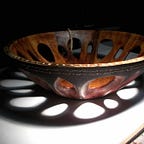Inertia. Stuck? Terminally?
SGHolland 2018
Talk to most 80-something artists— they will give you a pretty good description of art inertia unless they are very tightly-wound up, like Granny in the Beverly Hillbillies. (Can you imagine that fictional character ever running out of energy?) Artists are not usually able to spend whole lives wound-up like Granny.
A Medium writer recently described herself as hoping to find someone to revive her sparkle. She is bogged down with her drawing — is hoping for some inspiration from an artist or other person who can jump- start her motivation.
Well, welcome to a very large, usually anonymous club! Artists wring themselves dry even when they are piled high with avid fans. Why?
Without boring readers with the details, you could simply say that the eye no longer speaks to the hand. They have broken up.
Betty Edwards had some very good ideas in her best-selling books on Drawing on the Right Side of the Brain, and others. I can attest to the effectiveness of that book. While my excellent drawing instructors at Tyler School of Fine Art managed to coerce even the eyes of 19 year old freshman art students to get their logical, literate, critical left brains to stay out of the way, Betty Edwards’ exercises get right to the matter in a faster way — a little cruel — the tricks she requires of any artist, young or seasoned!
It doesn’t matter if you’re experienced or not when you are forced into drawing without looking at your work unfolding, or drawing with your non-dominant hand, or drawing when the subject is an upside down photo, or drawing just a small section of a live subject (such as yourself looking through a small peek-hole into a mirror. Just the nose and mouth, for instance.)
All of these things “put you out of your mind!” Frustration is the result.
But the drawings that evolve will surprise the socks off your feet!
The more you do it the more amazed you are at the marks your hand puts on the paper.
Drawing from a live subject is especially exciting. It is as if your eye is the tool that marks the paper. Your eye travels all the perimeters of what is standing before you and you “dance” your instrument (hand with pencil or brush or even just a finger in the sand) along the route your eye travels. Not naming the object, but just “feeling it” with your eye.
Taken out of “logical context” the objects become shapes with no particular names. They are elements of positive or negative shapes. One cannot describe these shapes with labels or words. A finger-tip becomes a bread-like lump with what seems to be a purposeless shape — a dent here — a shadow there — and that lump’s shape is determined by the little strip of blank nothingness beside it.
The no-shape has a shape of its own that wanders around in a way that has no particular logic! It shows what ISN’T!
This “nothing” is the shape you draw!
Magic!
Amazingly soon, your hand understands its role — just to move around in the direction your eye is going on a surface that you are not looking at.
You draw with a shroud on your easel so you can NOT look at your drawing at all.
You don’t disconnect your eye from the object you are looking at, and you don’t disconnect your pencil from the paper! Your lines can be as free as they want to go back or cross over each other over there where your hand and the paper are doing something that your eye is experiencing — up and down in space and around shapes and into small and large swirls and swoops and detailed little scribbles. You will become friends with this kind of eye-hand connection. Your drawings will get more and more sparkling.
Why Do This? — -Because your drawing will never be the way it used to be when you were being confused with all kinds of myths that your logic (left brain) will tell you. Myth? →For instance, that hands are square-ish things with four appendages of small, medium and large and a fifth,stumpy one, — the thumb. This is not true of all hands your eye sees, or even of the same hand at a different place in space. Square things with five appendages are symbols of hands. Not portraits of hands. A fist doesn’t look like this, nor does a pointing finger.
Square-ish forms with five appendages are symbols of hands — not true representational drawings of hands.
Try changing the lighting. The shapes change drastically when the light comes from another direction onto the object of your drawing.
Try this with a different medium. Get some acrylic paint or charcoal, or a sooty finger, and let it take the eye-journey as you look at the shapes.
Use a generously fat tablet of paper and tear off your fresh paintings often. Start new ones while you are still in the right brain mode. Throw a lot of really terrible drawings away. They will not all be “good.” But there will be some that sparkle. Keep them.
SGH © Last day of December 2018
My gratitude for use of illustration, credited in caption link.
